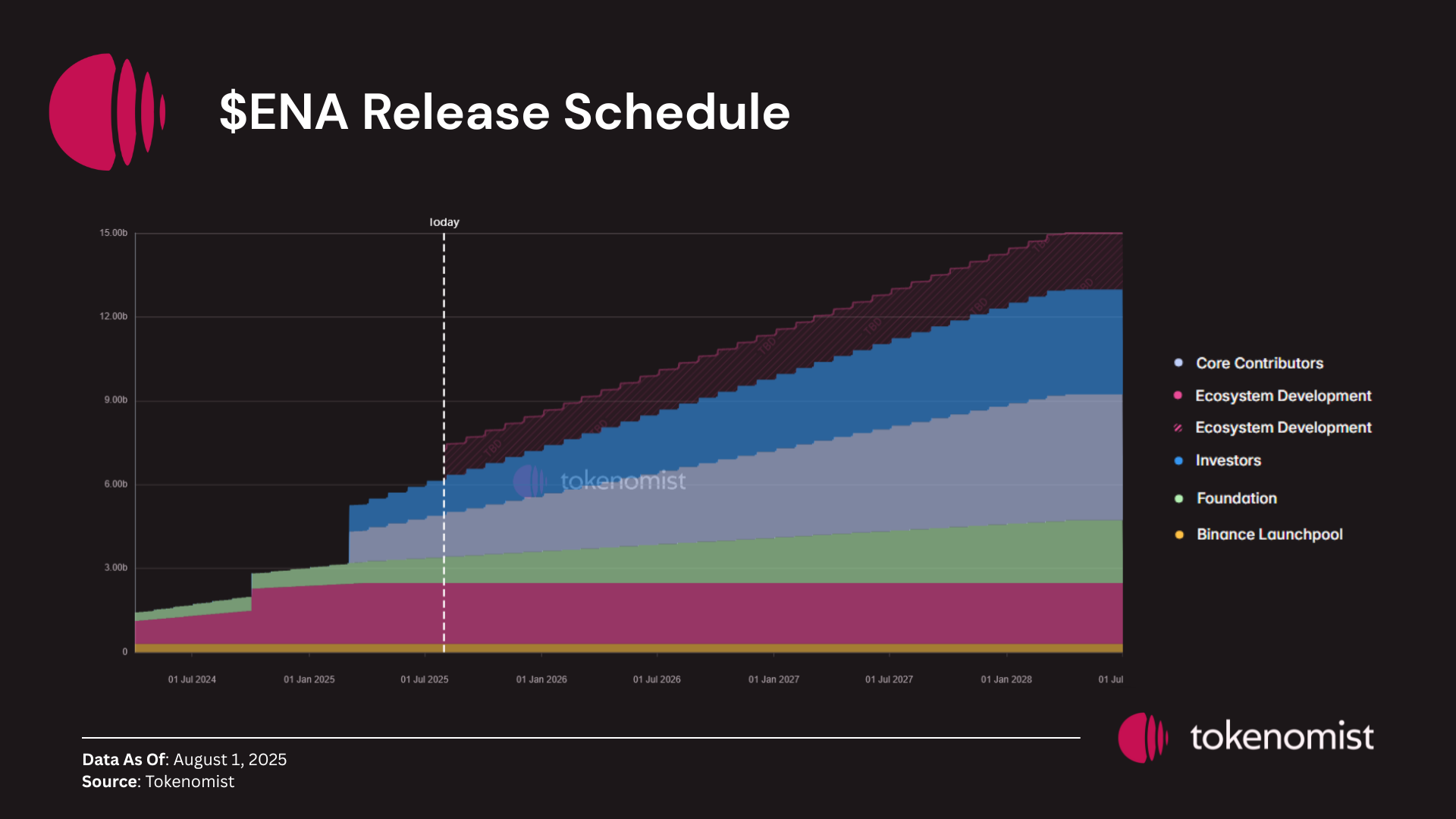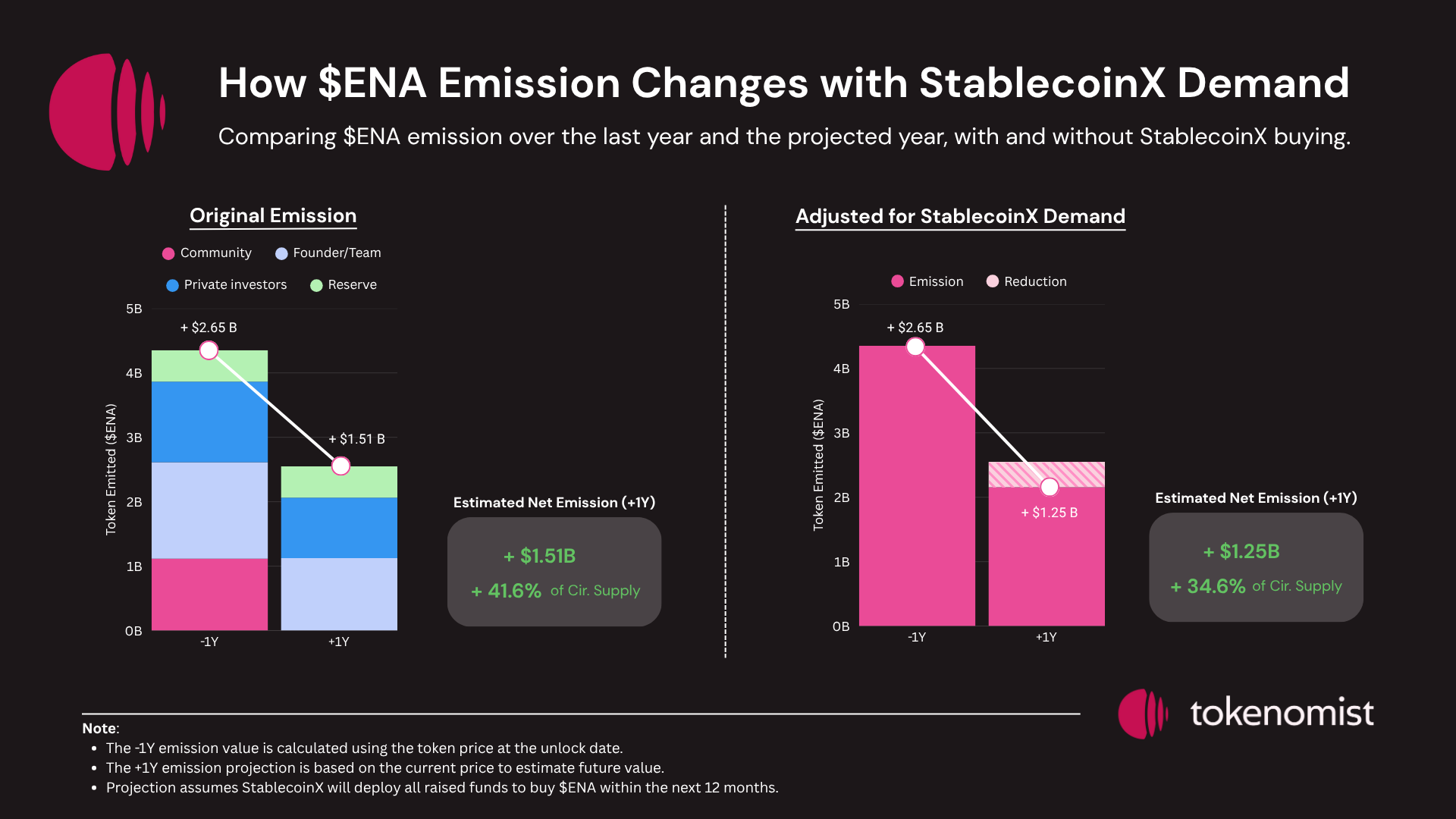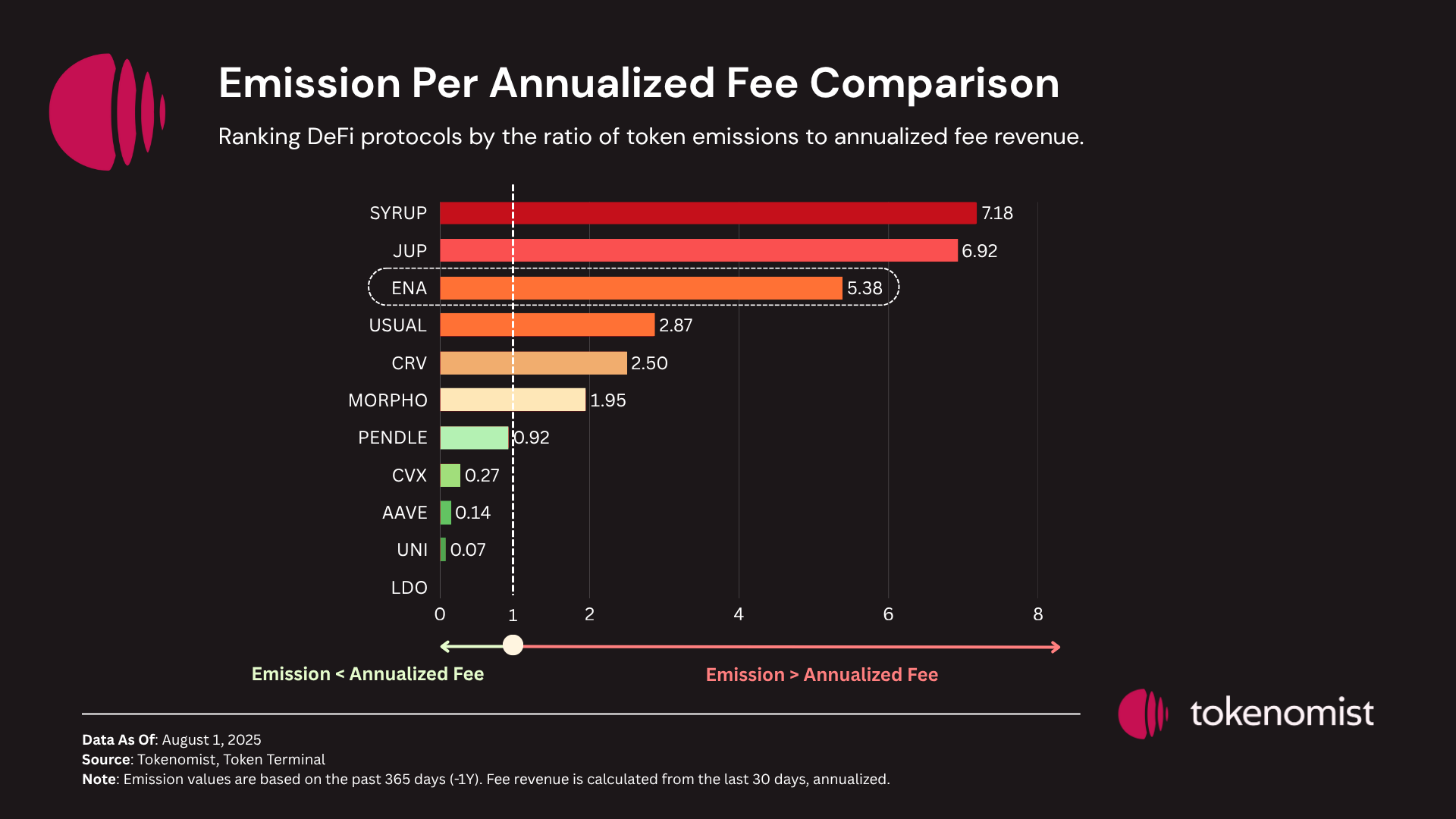ENA: The Stablecoin Bet

TL;DR
- Ethena (ENA) is getting a lot of attention after StablecoinX announced a $360M raise and a $260M ENA buyback over six weeks (~8% of supply). The protocol makes strong revenue ($307M in the past year) by keeping 20% of USDe yields from perp funding, ETH staking, and T-bill returns.
- Bullish side: The approved fee switch could send part of this revenue to sENA holders—base case yield is around 4%, with a bull case above 10%. Other growth drivers include the Converge Chain L2 launch and USDtb, a GENIUS Act–compliant stablecoin. The buyback also lowers next year’s net emissions from 41.6% to 34.6%.
- Risks: Over $1.1B in private/team unlocks in the next year, plus another $1.1B+ in “TBD” ecosystem allocation. ENA’s emission-to-revenue ratio is high compared to other DeFi protocols, and the model hasn’t been tested in a long bear market.
Stablecoins are becoming the backbone of crypto, powering payments, trading, and DeFi. With the recent GENIUS Act giving them a legal framework in the U.S. and Circle’s IPO showing huge investor demand, the sector is entering a new phase of growth.
In the middle of this, Ethena and its token $ENA have taken the spotlight. The launch of StablecoinX, a treasury arm following the “Strategy” (formerly MicroStrategy) playbook, has made ENA one of the hottest topics on Crypto Twitter.
fuck it
— Ethena Labs (@ethena_labs) July 25, 2025
saylor mode
But hype alone doesn’t tell the full story. This report dives into ENA’s tokenomics, emissions, and value drivers—highlighting both the opportunities and risks that investors should keep in mind:
- Tokenomics Overview - Current supply dynamics and distribution structure
- Key Catalyst: StablecoinX Capital Raise - The $360M raise and planned token buybacks
- Revenue and Value Accrual - Protocol economics, fee switch mechanics, and yield projections
- Risks and Unlock Overhang - Supply risks, emissions analysis, and long-term sustainability concerns
Tokenomics Overview
- Total Supply: 15 Billion
- Circulating Supply: 6.35 Billion (42.36% of total supply)


Key Catalyst: StablecoinX Capital Raise
The market recently turned bullish on ENA following a major announcement from StablecoinX, Ethena’s newly established treasury arm. StablecoinX disclosed a $360 million capital raise dedicated to purchasing ENA, alongside plans to list its Class A common shares on the Nasdaq Global Market under the ticker USDE. The raise includes a $60 million ENA contribution from the Ethena Foundation.
According to the deployment plan, StablecoinX will allocate approximately $5 million per day into ENA purchases over the next six weeks. At current prices, the planned $260 million in open-market buys would represent roughly 8% of ENA’s circulating supply, creating a strong demand-side catalyst and fueling renewed bullish sentiment.

Following the planned $260 million ENA buyback by StablecoinX, Ethena’s net emissions profile has shifted meaningfully. Over the next 12 months, ENA’s net emission is projected to decline from 41.6% of circulating supply to 34.6%, as illustrated in the diagram above. This effectively reduces sell pressure in the near term and strengthens the bullish narrative.
Revenue and Value Accrual
Ethena generates protocol revenue by capturing 20% of all USDe yield. This yield comes from three primary sources:
- Perpetual funding rates from delta-neutral positions
- ETH staking rewards
- Tokenized T-bill yields, such as BUIDL
The remaining 80% of yield is distributed to sUSDe holders, making Ethena one of the few stablecoin protocols with a built-in value accrual loop for both users and the protocol treasury. See Ethena Docs for more.
As of now, cumulative protocol revenue has reached $405.8 million, with $306.7 million generated in the past 12 months alone. However, it’s important to note that Ethena’s revenue is closely tied to market sentiment. Funding rates usually rise in bullish markets, increasing returns, but can drop or even turn negative when markets turn bearish. This dynamic makes Ethena’s revenue model both scalable and heavily tied to market cycles. Investors should be cautious, as the protocol is still new and has yet to face a prolonged bear market.
Fee Switch Progress
Another major catalyst for ENA lies in the fee switch, a governance proposal introduced by Wintermute and already approved by the protocol Risk Committee. Once activated, the fee switch will allow a portion of Ethena’s protocol revenue to flow directly to sENA tokenholders, creating a more direct value accrual mechanism.
Activation, however, is contingent on several criteria being met:
- USDe circulating supply surpassing $6 billion
- Cumulative protocol revenue exceeding $250 million
- CEX integration of USDe on at least 4 of the top 5 centralized exchanges by derivatives volume
- Reserve fund growing to 1% or more of the USDe supply
- Widening the yield spread between sUSDe APY and competing benchmarks, such as Aave’s USDC
As of today, most of these benchmarks have already been achieved. The remaining hurdles are growing the reserve fund and increasing the relative APY spread to cement sUSDe’s competitiveness against other stablecoin yield products. The timeline for fee switch activation is therefore approaching, and once triggered, it represents a critical unlock for ENA’s long-term tokenholder value.
sENA Potential Yield Under Different Scenarios
To evaluate how the fee switch could impact ENA tokenholders, we conducted a scenario analysis modeling different outcomes for protocol revenue growth and fee split ratios between sENA and sUSDe holders.
- YoY Revenue growth scenarios: –50%, –25%, 0%, +25%, +50%, +75%, +100%
- Fee split scenarios: Conservative (5%), Moderate (10%), Aggressive (15%)

The results show that even under no revenue growth and with a 10% fee split directed to sENA, the projected yield remains well above 4%—already higher than staking ETH directly. More optimistic revenue growth or higher fee split assumptions naturally boost potential returns further, making sENA an attractive yield-bearing asset once the switch is live.

That said, it is important to stress that these are hypothetical projections. The actual fee split percentage has not yet been finalized, and real-world outcomes will depend heavily on both market conditions and governance decisions.
Strategic Partnerships and Product Expansion
Beyond its core stablecoin business, Ethena is expanding its ecosystem to unlock new sources of growth and value accrual for ENA holders.
First, the team is building Converge Chain, an Ethereum Layer 2 built on Arbitrum. Converge will serve as the home for Ethereal, a native perpetual DEX, along with other dApps in the Ethena ecosystem. This initiative introduces fee-based revenue streams beyond USDe and creates additional pathways for ENA value capture.
Second, Ethena Labs has entered a strategic partnership with Anchorage Digital to launch USDtb, the first stablecoin designed with a clear pathway to regulatory compliance under the newly enacted GENIUS Act. This partnership positions Ethena to lead the next phase of U.S. stablecoin adoption and strengthens its credibility with institutional players.
Since GENIUS, yield bearing stablecoins actually lead in supply growth, with @ethena_labs adding a massive $2.7bn
— Artemis (@artemis) August 3, 2025
Never count @tether out either pic.twitter.com/jeGtrO9Lfh
Together, these developments highlight Ethena’s ambition to evolve from a single-product protocol into a broader ecosystem, with multiple revenue drivers and deeper regulatory alignment.
Risks and Unlock Overhang
While recent catalysts such as the StablecoinX buyback help offset near-term dilution, investors should remain cautious about Ethena’s long-term supply dynamics. Over the next 12 months alone, more than $500 million in tokens will unlock to private investors, alongside roughly $640 million allocated to the founding team and early contributors. These upcoming unlocks represent significant potential sell pressure and underscore the importance of looking beyond short-term bullish narratives.
Adding to this complexity is Ethena's massive ecosystem development allocation, which remains largely undetermined. Currently in Season 4 of its airdrop campaign (started in March 2025), Ethena has already distributed 2.25 billion ENA tokens across the first three seasons at 750 million tokens each. With Season 4 ongoing and an additional 13.5% of total supply (roughly 2 billion tokens worth ~$1.1 billion at current prices) earmarked for future ecosystem development, the protocol sits on what amounts to a $1+ billion uncertainty. This allocation dwarfs most DeFi treasuries and represents potential dilution that could overwhelm any fee switch or buyback mechanism, making the timing and deployment strategy of these tokens critical to ENA's long-term value proposition. Visit Tokenomist for more ENA unlock details.
The diagram below highlights the ratio of token emissions to annualized fee revenue (calculated using the last 30 days of protocol data). A higher ratio suggests that tokens are being emitted at a much faster pace than fees are being generated—effectively illustrating how much the protocol dilutes token value to produce $1 of revenue. While not a perfect analogy, it is a useful lens for comparing sustainability across protocols.

In this context, ENA shows a relatively high ratio compared to other leading DeFi protocols, pointing to the reality of large unlocks and ongoing supply expansion. This dynamic should be top of mind for investors when evaluating ENA’s long-term investment case.
Conclusion
Ethena has quickly positioned itself as one of the most innovative players in the stablecoin and synthetic dollar landscape. With strong revenue generation, a growing ecosystem, and catalysts like the StablecoinX buyback and upcoming fee switch, the protocol offers meaningful value accrual potential for ENA holders. At the same time, investors should balance this optimism with caution. Significant insider unlocks, reliance on market-dependent revenue, and a still-unproven track record through a full market cycle remain key risks. Ultimately, ENA represents both high upside in a favorable environment and notable supply risks that must be carefully weighed in any long-term investment thesis.



